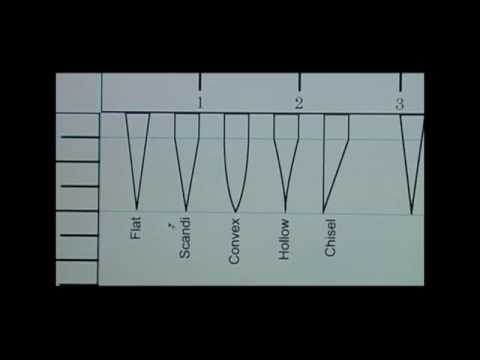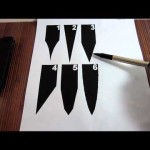
2123add374d13104fd0776b3a2856b4d
Knives are essential tools in the kitchen, and the type of edge on the blade can make a big difference in how well it performs. In this article, we’ll explore the different types of knife edges and how they can affect the way you use your knife. We’ll look at the pros and cons of each type of edge, as well as how to care for and maintain them. By the end, you’ll have a better understanding of the different types of knife edges and how to choose the right one for your needs.
What is the edge geometry of a knife
The edge geometry of a knife is the shape of the blade’s cutting edge. It is an important factor in determining the performance of a knife, as it affects the sharpness, durability, and ease of sharpening. The most common edge geometries are straight, serrated, and hollow ground.
Straight Edge – A straight edge is the simplest and most common edge geometry. It is a single, flat bevel that runs along the length of the blade. This type of edge is easy to sharpen and maintain, and is suitable for most everyday tasks.
Serrated Edge – A serrated edge is a series of small, sharp teeth along the length of the blade. This type of edge is designed to cut through tough materials, such as rope or leather. It is more difficult to sharpen than a straight edge, but it is also more durable.
Hollow Ground Edge – A hollow ground edge is a concave bevel that runs along the length of the blade. This type of edge is very sharp and is suitable for precision cutting tasks. It is also more difficult to sharpen than a straight or serrated edge.
The edge geometry of a knife is an important factor in determining its performance. Different types of edges are better suited for different tasks, so it is important to choose the right edge geometry for the job. With the right edge geometry, a knife can be a reliable and effective tool.
What is the best edge for a knife
When it comes to knives, the edge is one of the most important features. The edge is the sharpened part of the blade that is used to cut and slice. Different types of edges can be used for different tasks, so it is important to know which edge is best for your needs.
Straight Edge – This is the most common type of edge and is used for general purpose cutting. It is easy to sharpen and maintain, and is suitable for slicing, chopping, and dicing. It is not as sharp as other edges, but it is still a good choice for everyday use.
Serrated Edge – This type of edge is designed for cutting through tough materials such as rope or leather. It is not as sharp as a straight edge, but it is more durable and can be used for a longer period of time. It is also easier to sharpen than a straight edge.
Chisel Edge – This type of edge is designed for precision cutting. It is very sharp and can be used for detailed work such as carving or engraving. It is not as durable as other edges, so it should be used with care.
Hollow Edge – This type of edge is designed for slicing and dicing. It is very sharp and can be used for slicing thin pieces of food. It is not as durable as other edges, so it should be used with care.
When choosing the best edge for your knife, it is important to consider the type of tasks you will be using it for. Different edges are better suited for different tasks, so it is important to choose the right one for your needs.
With the right edge, you can ensure that your knife will perform its best.
What is the most common knife edge
Knives come in a variety of shapes and sizes, and each type of knife has its own unique edge. The most common type of knife edge is the straight edge. This type of edge is found on most kitchen knives, pocket knives, and utility knives. It is also the most common type of edge used in the manufacturing of knives.
A straight edge is created by grinding the blade of the knife in a single direction. This creates a sharp, straight edge that is easy to maintain and sharpen. The straight edge is also the most durable type of edge, as it is less likely to chip or break than other types of edges.
The serrated edge is another common type of knife edge. This type of edge is created by grinding the blade in a saw-like pattern. This creates a jagged edge that is great for cutting through tough materials such as rope or leather. Serrated edges are also great for slicing through food, as they can easily cut through tough skin or fibrous material.
The chisel edge is a less common type of edge, but it is still used in some applications. This type of edge is created by grinding the blade in a V-shape. This creates a sharp, angled edge that is great for cutting through hard materials such as wood or metal. Chisel edges are also great for carving and whittling.
No matter what type of knife edge you choose, it is important to maintain it properly. Regular sharpening and honing will help keep your knife edge in top condition. It is also important to use the right type of knife for the job, as using the wrong type of edge can cause damage to the blade or the material being cut.
What is the difference between a concave and convex knife edge
Knives come in a variety of shapes and sizes, and the type of edge they have can make a big difference in how they perform. The two most common types of knife edges are concave and convex. Knowing the difference between the two can help you choose the right knife for the job.
Concave knife edges are curved inward, like a bowl. This type of edge is best for slicing and chopping, as it allows the blade to cut through food more easily. It also helps to reduce the amount of friction between the blade and the food, which can help to prevent food from sticking to the blade.
Convex knife edges are curved outward, like a dome. This type of edge is best for piercing and stabbing, as it allows the blade to penetrate food more easily. It also helps to reduce the amount of drag on the blade, which can help to prevent food from slipping off the blade.
When choosing a knife, it is important to consider the type of edge that is best suited for the task at hand. For example, if you are looking for a knife to use for slicing and chopping, a concave edge is likely the best choice. On the other hand, if you are looking for a knife to use for piercing and stabbing, a convex edge is likely the best choice.
No matter which type of edge you choose, it is important to maintain your knife properly. This includes sharpening the blade regularly and cleaning it after each use. Doing so will help to ensure that your knife performs at its best and lasts for many years.
Thank you for exploring the different types of knife edges with us. We hope you have a better understanding of the different types of edges and how they can be used. Goodbye and have a great day!













